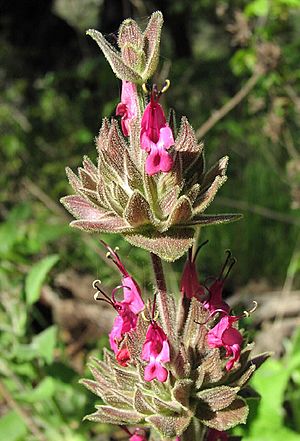California hummingbird sage facts for kids
Quick facts for kids California hummingbird sage |
|
|---|---|
 |
|
| Salvia spathacea, Gaviota State Park, California | |
| Scientific classification | |
| Genus: |
Salvia
|
| Species: |
spathacea
|
The Salvia spathacea, also known as the California hummingbird sage, hummingbird sage, or pitcher sage, is a beautiful flowering plant. It belongs to the mint family called Lamiaceae. This plant naturally grows in southern and central California, from sea level up to about 610 meters (2,000 feet) high.
This special sage has a lovely fruity smell. Its flowers usually bloom from March to May and are often a dark rose-lilac color. People love to grow it in their gardens because of its pretty flowers and nice scent.
Contents
Where Does Hummingbird Sage Grow?
You can find the pitcher sage along the California coast, from the Sacramento Valley all the way south to the San Diego area. It's a common plant that likes to grow on open or shady hillsides. It thrives in damp oak forests, chaparral (a type of shrubland), and coastal sage scrub areas. These places are usually not far from the Pacific Ocean.
What Does Hummingbird Sage Look Like?
The Salvia spathacea is an evergreen perennial plant. This means it stays green all year and lives for many years. It grows flowering stems from a woody base, reaching about 30 to 150 centimeters (1 to 5 feet) tall. When it's not flowering, the plant forms clumps of leaves that are less than 50 centimeters (20 inches) tall.
Each plant usually grows just one flowering stem, which rarely branches out. It spreads using underground stems called rhizomes. This allows it to form large groups of plants up to 130 centimeters (51 inches) wide. Like many plants in the mint family, it has very clear square stems. The whole plant is covered with soft, wavy, glandular hairs.
Leaves of the Sage
Its bright green leaves are about 8 to 20 centimeters (3 to 8 inches) long. They smell very strong and pleasant when you crush or touch them. The leaves are oblong, meaning they are longer than they are wide, and can be shaped almost like an arrowhead at the bottom. They might also look wrinkled and have rounded teeth along their edges. Just like the rest of the plant, the leaves are covered with hairs, making them soft to touch. These hairs are usually thicker on the underside of the leaves.
Hummingbird Sage Flowers
The flowers grow in clusters called inflorescences. These clusters are about 15 to 30 centimeters (6 to 12 inches) long and 6 centimeters (2.4 inches) wide. They grow on spike-like stems, with flowers at each node on the top half of the stem. Underneath the flower clusters are colorful leaf-like parts called bracts. These can be ruby red, dark maroon, or even brown.
The calyx (the green part that holds the flower) is 1.5 to 3 centimeters (0.6 to 1.2 inches) long and has two lips. The upper lip is smooth, while the lower lip is longer. Each corolla (the colorful part of the flower) is tube-shaped and 2.5 to 3.5 centimeters (1 to 1.4 inches) long, also with two lips. The upper lip of the corolla has two small lobes, and the lower lip is longer.
The two fertile stamens (male parts) are attached to the flower tube. The style (female part) is forked. Both the style and the stamens stick out from the flower tube. The flowers can be various colors, from green to light pink, magenta, and even purple.
Seeds of the Plant
The fruits of the plant are tiny, dark brown to black nutlets. There are usually four of them. They are round or oval-shaped, and about 3.5 to 6.5 millimeters (0.14 to 0.26 inches) long.
Growing Hummingbird Sage in Your Garden
Salvia spathacea is very easy to grow in a garden. It makes a great groundcover for shady spots under oak trees, especially where it's dry. Unlike some other native California sages, this one spreads using its underground rhizomes. It can also grow well in open areas, in regular garden soil, and even in partial or full sun.
Giving it extra water can help it bloom for a longer time. However, it's good for the plant to have a break from watering in late summer. As its name suggests, this plant is a favorite food source for hummingbirds and will attract them to your garden. Deer and gophers usually leave this strongly scented plant alone, which is a big plus for gardeners!
How to Grow More Sage Plants
It's easy to grow new Salvia spathacea plants from seeds or by using its rhizomes. You should collect the seeds as early as possible, or insects might eat them. Sometimes, S. spathacea can get a plant disease called powdery mildew. You can treat this by spraying the plant with milk mixed with water.
There are several different types of Salvia spathacea called cultivars. Some of these are stronger than others. For example, "Confetti" is a showy type that has both yellow and pink flowers on the same plant. "Powerline Pink" is a more robust cultivar with magenta to crimson flowers. It can even grow in hot, sunny places, even away from the coast. "Avis Keedy" is another type that has light yellow flowers.
The Salvia spathacea has even won the Royal Horticultural Society's Award of Garden Merit. This award means it's an excellent plant for gardening.

